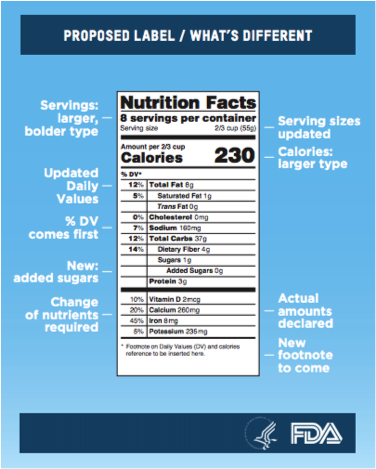New Tools To Empower The Healthy Consumer: Part II
November 21, 2014Only 50% of Americans read nutrition labels when shopping for groceries, and experts say labeling is not as helpful as it could be to inform food purchases for most consumers. New regulations proposed in February, 2014 by the Food and Drug Administration (FDA) are intended to highlight the information that is most important for consumers to limit serving size and make smarter food choices. First, the new rules tackle unrealistic serving sizes. Food manufacturers are currently able to keep calorie counts low by setting a serving size far below what the average person actually eats. Under the new rules, FDA will require serving sizes to align with recent food consumption data showing that portions Americans eat often far exceed the listed serving size on labels. In addition, calorie counts will be prominently displayed in larger and bolder type. In light of growing recognition that sugars added during processing have negative health consequences, (a serious concern given that the average American consumes 16% of her daily calories from added sugars), the new rules require added sugars to be listed separately.
Do these changes go far enough to help Americans understand the nutritional content of the foods they buy for themselves and their families? Probably not, says Jane Brody, health columnist for the New York Times. Brody says “traffic light signals” on the front of packages could give consumers a quicker way to judge the nutritional value of food products. Meanwhile WHO’s Department of Nutrition called for a standardized global food label system earlier this month, and a representative of the organization commented that color coding may be the easiest format for consumers to understand. FDA’s recent changes are an improvement on the old labeling system, but many health professionals believe more change is needed to leverage nutrition labels as a tool for protecting our nation’s health.
Brody, Jane. “Revised Food Labels Still Won’t Tell Whole Story.” The New York Times 26 Oct. 2014.
“Nutrition Facts Label: Proposed Changes Aim to Better Inform Food Choices.” Consumer Health Information. United States Food and Drug Administration, Feb. 2014.
Scott-Thomas, Caroline. “WHO calls for standardised nutrition labelling.” Food Navigator. William Reed Business Media, 28 Oct. 2014.
Comments are closed.
